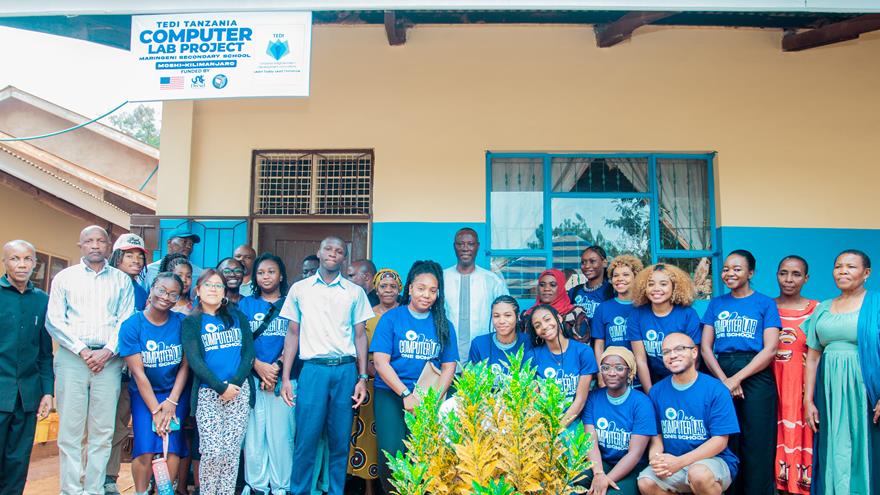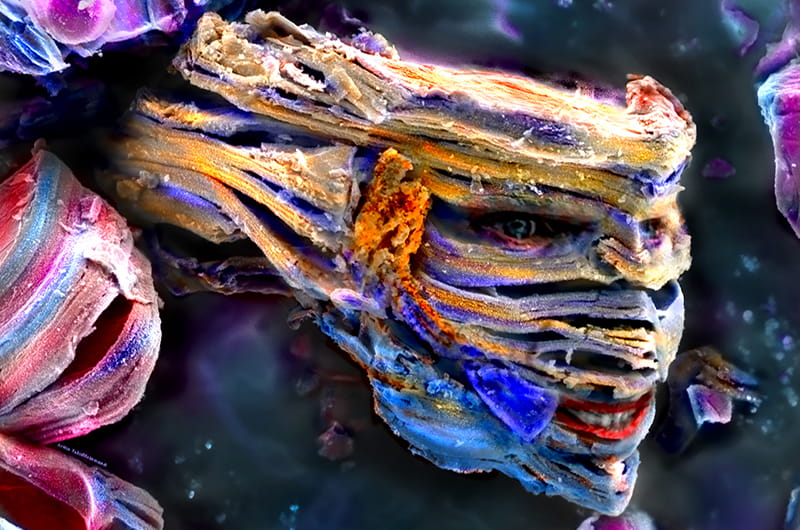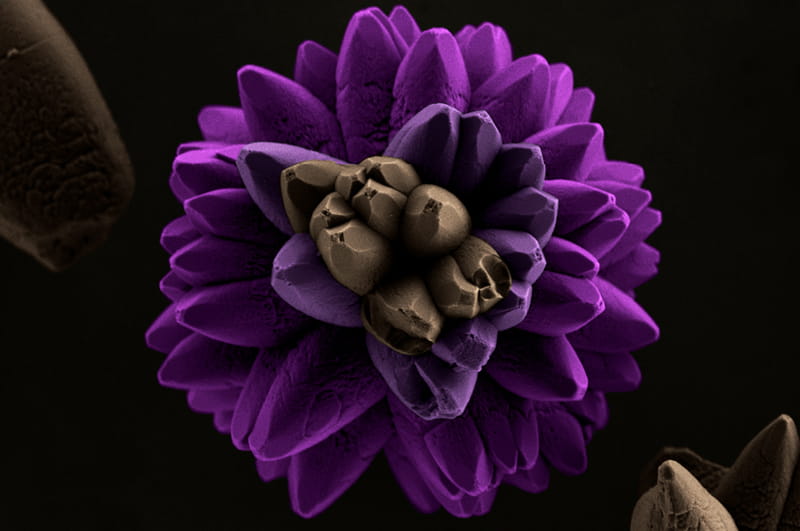The Drexel Collection’s New Exhibit Highlights Art at the Nanoscale

- Through Connections and Community, Drexel Course Helps Launch Computer Lab in Tanzania
- Drexel’s Pearlstein Gallery Offers Spring Exhibitions Centered on the Healing Properties of Art and Creative Works
- Drexel's Self-Heating Concrete Is One Step Closer to Clearing Sidewalks Without Shoveling or Salting
- Splunk Founder Michael Baum ’85 Shares Personal Philosophies, Entrepreneurial Advice and the Impact of His Drexel Co-ops

Scientists typically view materials under an electron microscope to understand how they work at very small scales — like, say, at the atomic level or at the nanoscale, with one nanometer equaling one billionth of a meter. But seen through the microscope lens, these materials can look quite artistic, even if that’s not the reason why they were being viewed in the first place.
These microscopic images are often colorized (electron microscopes show them in gray-scale) and edited with photo editing software to emphasize the unique features captured in ways the human eye could never make out. Plus, the scientists colorize their images not for their research, but to show the beauty within their research to a different, wider audience.
This field of scientific art — or artistic science — is known at Drexel as NanoArtography, a stylized portmanteau that combines “nano” with “art” and “photography.” The name was coined by a Drexel University student, and the competition itself was created at Drexel. The University is known as a giant in the nanomaterial research field as the birthplace of the MXene, a two-dimensional (2D) material that could lead to advances in everything from kidney transplants to functional fabrics to energy storage. But as much as Drexel is known for its materials research, it is also known for promoting the art of nanomaterials, having hosted a prestigious international nanoArtography photo contest since 2016.
Now, some of those award-winning images are going to be on display in a new exhibit from The Drexel Collection, the University’s flagship collection of art. NanoArtography, which will be displayed in the Rincliffe Gallery from Dec. 14 to March 15, will demonstrate how closely science and art are intertwined, especially at an institution like Drexel.
“I want this show to make people aware that we have such strengths in nanomaterials at Drexel, and that engineering is not just about solving equations,” said Babak Anasori, PhD ’14, a research assistant professor in the College of Engineering who created and runs the A.J. Drexel Nanomaterials Institute NanoArtography Competition. “Some people might not know that much about engineering, and materials science, in particular. With this show, we can have students with different backgrounds interested in our research and I hope they will be more eager to learn about our field.”
Anasori was a materials science and engineering doctoral candidate in Drexel’s Department of Materials Science and Engineering when an electron microscope image he created of a titanium-based MXene was recognized and awarded in the scientific field (it won the People’s Choice award in the National Science Foundation’s International Science & Engineering Visualization Challenge) as well as in the mainstream media, appearing in National Geographic and on MSNBC. Inspired by how his art, and science, was received, he started Drexel’s annual NanoArtography contest, which is run through the A.J. Drexel Nanomaterials Institute and is open to students and researchers from across the country and around the world.
“Such competitions exist in the scientific community that promote presenting science as art,” said Anasori. “But usually the art is only shared in scientific fields, and the judges are scientists. The NanoArtography competition is shared online and can be accessed by anyone. And I created a panel of judges of both scientists and artists, so there’s real art and scientific expertise being used to choose the winners. Plus, the public can choose a ‘people’s choice’ winner by voting on their favorite picture.”
Every year of the competition has garnered over 100 submissions, and researchers from over 20 different countries, from Mexico to India to Germany to Australia, submitted images of their research last year to illustrate what they are studying — and showcase its beauty. The students and researchers were judged on submissions that were visually intriguing and stunning, and also told a story about the research being conducted.

Now, for the first time, the images from the competition will be displayed in a real art exhibit, rather than just online, through the NanoArtography show.
“This is really exciting for me because when I started the NanoArtography competition, I was excited about having this international competition that everyone can participate in,” said Anasori. “I didn’t envision displaying the pieces in an art gallery only within three years of starting the competition. I’m thankful to The Drexel Collection for putting this show together.”
Anasori and Lynn Clouser, director of The Drexel Collection, worked together to choose images that would both broaden the public’s understanding of the world at the atomic level and also connect various art movements and features in the scientific images. NanoArtography shows how everything from pop art to Impressionism to iconography can be linked to the atomic images. At a time when art is being created by algorithms and artificial intelligence (as described in a recent New York Times article), NanoArtography calls into question what art truly is and how it can be created and defined.
“The Drexel Collection was founded in 1891 with the intention of being a teaching tool for the then-Drexel Institute of Art, Science and Industry to show students examples of good design in craftsmanship,” said Clouser. “Today, the Collection regularly offers so many different opportunities to partner with departments across campus and I love that with this show, instead of students learning about good design from the Collection, the Collection — and hopefully the rest of the Drexel community — is learning about new materials from the College of Engineering.”
The exhibit’s opening reception will be held Dec. 14 from 5–7 p.m. in the Anthony J. Drexel Picture Gallery and Rincliffe Gallery on the third floor of Drexel’s Main Building, which is located at 3141 Chestnut St. NanoArtography will be on display in the Rincliffe Gallery from Dec. 14 to March 15. Both the exhibit and the opening are free.
In This Article
Drexel News is produced by
University Marketing and Communications.
